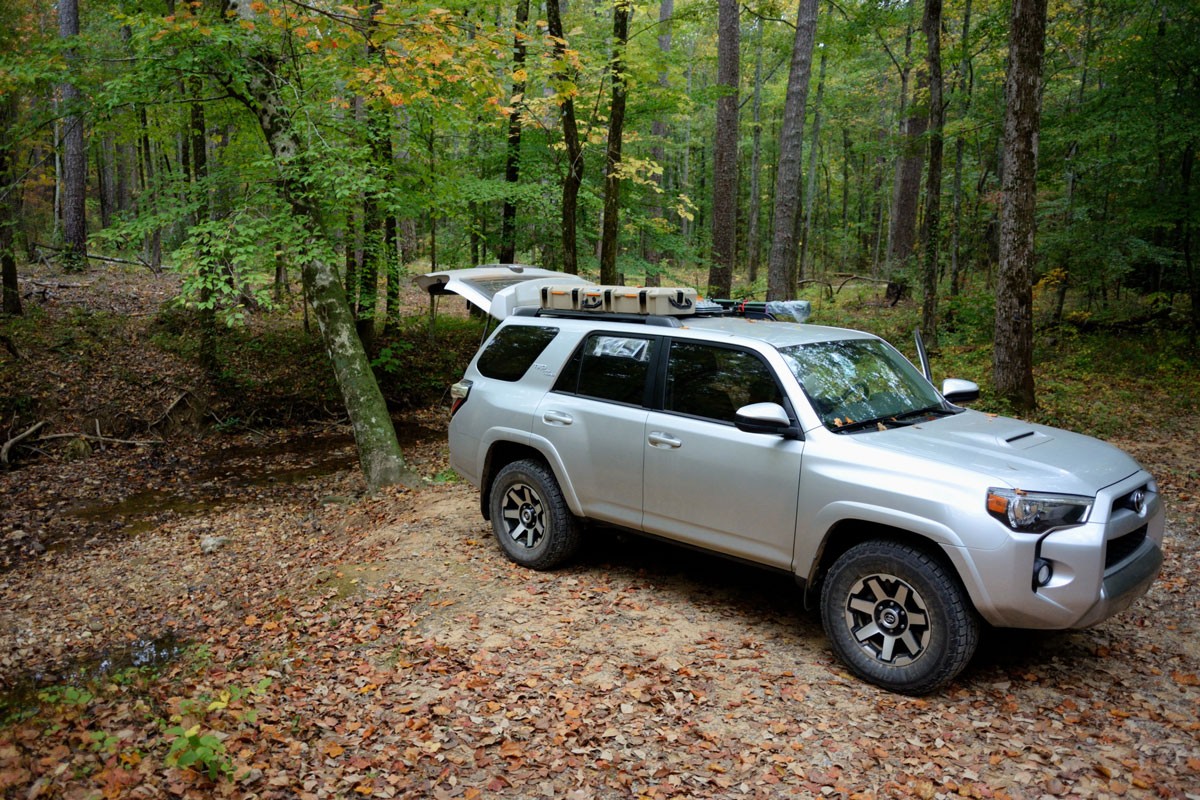You took your Toyota 4Runner for a quick drive but suddenly hear a rattling noise as you step on the gas. Now you’re wondering what could be making that noise as you accelerate. We researched this concern for you to give you this answer.
A Toyota 4Runner that’s making a rattling sound upon accelerating may have an underlying issue. Make sure that you repair your Toyota 4Runner based on the source of the rattling noise. Take note that this racket can come from different origins, such as:
- Low transmission fluid
- Unsecured engine mount
- Faulty Torque Converter
- Loose V-belt pulley
- Broken heat shield
Keep reading as we talk about these underlying issues in greater detail. We’ll also discuss a possible solution to help you get rid of this unwanted racket.

Why Is My Toyota 4Runner Making A Rattling Noise When Accelerating?
The rattling noise you hear from your Toyota 4Runner may come from different sources. Some possible suspects are:
Low Transmission Fluid
Transmission fluid helps keep the engine cool by lubricating the bearings, metal parts, and other assemblies in your 4Runner’s transmission system. So low transmission fluid reserves may make certain components grind against other parts, causing the rattling noise.

Unsecured Engine Mount
As its name implies, the engine mount holds the engine block. If it’s loose, the 4Runner's engine may move around as you're accelerating. This concern may also make different parts under the hood jiggle and sway, even when you're driving at cruising speed.
Failure to rectify this problem can lead to serious issues. For instance, frequent rattling may cause leaks. Liquids from your engine block may then enter other components, which might lead to total engine failure.
Faulty Torque Converter
You can generally find torque converters in automatic transmission vehicles, such as some Toyota 4Runner models. In comparison, manual transmissions have clutch systems.
The torque converter helps manage the engine fluid for different functions like promoting the sufficient amount of force required to step on the gas to accelerate the car. But a bad torque converter can rattle, even when increasing your 4Runner’s speed at a relatively slow pace.
Also, the volume and frequency of the rattling might increase the more you accelerate the vehicle. If so, replacing this assembly is perhaps your best option to fix this problem.
You can also watch this video to learn more about a car’s torque converter:
Loose V-Belt Pulley
A car’s V-belt pulley system works by optimizing different features and properties, including speed and traction. It manages power transference throughout your 4Runner, allowing the car to drive forward or backward when needed.
But a loose V-belt pulley may generate a rattling sound as you accelerate your vehicle. It’s because the looseness may cause metal-on-metal grinding, creating the racket.
Aside from a rattling noise, you may also hear a light chirping or squeaking reverberating from the mid-sized SUV. These sounds can come from damage like cracks and splits.
Watch the video below to help you troubleshoot and diagnose your pulley systems, including the V-belt:
Broken Heat Shield
A rattling noise coming from a 4Runner’s exhaust as you accelerate can indicate a problem with the SUV’s heat shield. This particular problem may also come with a burning smell from the car’s engine.
Take note that your 4Runner will become vulnerable to overheating if its heat shield becomes faulty or breaks down. This protective barrier that should secure your car’s exhaust system may not experience proper heat transference. The rattling may also increase in intensity and frequency as you drive at faster speeds.
Make sure to park your 4Runner in a safe, shaded area if you want to check the integrity of its heat shield. Also, let the vehicle’s engine cool down for several hours so you don’t burn yourself while touching the exhaust system.
How Do I Fix A Rattling Noise In My Toyota 4Runner When I Accelerate?

You should only use the appropriate solution based on the origin of the rattling sound. Otherwise, fiddling around with your Toyota 4Runner haphazardly may result in further damage to the vehicle.
In this section, you’ll learn how to drain and refill the SUV’s transmission fluid. Don’t forget that you should only follow these steps if the vehicle needs a transmission fluid refill. Otherwise, troubleshoot your 4Runner further or let a trustworthy automotive repair and maintenance shop do it for you.
Draining And Refilling The Transmission Fluid
First, turn off the engine in the SUV. Then open the hood of your Toyota 4Runner and search for the transmission dipstick. If your vehicle doesn’t have one, you may need to purchase a dipstick before you can continue.
Continue with the following steps once you confirm that your 4Runner is low on transmission fluid:
What You’ll Need
- Transmission fluid
- 3/8-inch flex head ratchet
- Adjustable socket wrench
- Jugs or large bottles
- Drain pan
- Funnel
- Washers
Step-by-Step Guide
Step #1: Drain The Leftover Fluid
Assuming that you already parked the car in a safe and shaded area, and the hood is open, remove or loosen the transmission fluid dipstick. Then crawl under the 4runner and find the transmission fluid reservoir.
Use your adjustable socket wrench and remove the drain bolt. Ensure that the drain pan is already underneath the container because the leftover transmission fluid will flow almost immediately upon removing the bolt.
Remove the old washer on the transmission fluid reservoir and replace it with a new one. Return the drain bolt once the fluid stops dripping afterward.
Step #2: Measure The Fluid
Place the funnel into the opening of one of your large jugs or bottles. Next, pour the transmission fluid from your vehicle into the container.
Pour the new transmission fluid into another clean jug or bottle. Make sure that the amount of the new transmission fluid is the same or closely similar to the removed volume.
Step #3: Pour The New Transmission Fluid
Remove the transmission fluid dipstick from the 4Runner’s engine block. Place the funnel into the opening and pour the new fluid into it.
Warning: It may take a while for the transmission fluid to enter the reservoir. So you may need to stop pouring if you can see the fluid levels rising in the funnel. Wait for the transmission fluid in the funnel to deplete before resuming the application.
Return the dipstick and take your Toyota 4Runner for a test run. At this point, the rattling should disappear. If the racket persists, you may need to troubleshoot the SUV further.
Check out this automatic transmission fluid on Amazon.
You can also watch the video to gain additional insights into this procedure:
Also, watch this video if you need help in choosing the correct transmission fluid for your Toyota 4Runner:
Are 4runners High Maintenance?

Toyota 4Runners are reasonably reliable SUVs. Maintenance costs are also typically lower for a 4Runner than other vehicles.
In particular, you should expect to spend about $514 in annual maintenance costs if you’re a 4Runner owner. On the other hand, a Land Rover Range Rover will usually require approximately $1,241 to $1,248 in yearly maintenance expenses.
Do 4Runners Have A Lot Of Problems?

Although Toyota 4Runners are usually reliable SUVs, some models might be susceptible to some relatively common problems. Some of these potential issues are:
- Airbag system deployment failure
- Faulty door lock actuators
- Blown head gaskets
- Increased rust and corrosion
- Locked rear differentials
- Suspension sag
- Power steering leak
If you experience at least one of these problems, you can contact your car dealer or Toyota's customer care service to help you identify your next actionable step. Keep in mind that you may need to send your vehicle back to your automotive dealer, especially if the problem is serious.
How Long Do Toyota 4runners Usually Last?

The typical Toyota 4Runner usually lasts around 300,000 miles or more, particularly if you follow a strict care and maintenance routine for the SUV. On average, this vehicle should last at least 200,000 miles before needing significant parts repairs and/or replacements.
Final Words

A Toyota 4Runner may encounter rattling noises because of a range of underlying problems. Check areas like the vehicle’s transmission fluid levels, engine mount, and the integrity of its heat shield to diagnose the source of the sound. Once found, employ the best procedure to enjoy long-term results.
If you liked this post and want to know more about the Toyota 4Runner, check out these other great reads:

